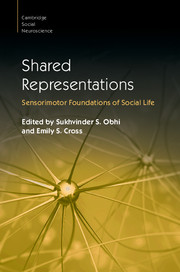Book contents
- Shared Representations
- Cambridge Social Neuroscience
- Shared Representations
- Copyright page
- Contents
- Figures
- Tables
- Boxes
- Contributors
- Preface
- Part I Foundations
- Part II Imitation and Mimicry
- Part III Thinking, Perceiving and Acting with Others
- Part IV Understanding Others
- 15 The Social Function of the Human Mirror System
- 16 Biological Tuning of Mirror Mechanisms
- 17 Representation of Self versus Others’ Actions
- 18 Reading Intention in Action
- 19 Complementary Actions
- 20 Emotional Convergence
- Part V Learning and Development
- Part VI Shared Representations in Applied Contexts
- Index
- Plate Section (PDF Only)
- References
17 - Representation of Self versus Others’ Actions
from Part IV - Understanding Others
Published online by Cambridge University Press: 27 October 2016
- Shared Representations
- Cambridge Social Neuroscience
- Shared Representations
- Copyright page
- Contents
- Figures
- Tables
- Boxes
- Contributors
- Preface
- Part I Foundations
- Part II Imitation and Mimicry
- Part III Thinking, Perceiving and Acting with Others
- Part IV Understanding Others
- 15 The Social Function of the Human Mirror System
- 16 Biological Tuning of Mirror Mechanisms
- 17 Representation of Self versus Others’ Actions
- 18 Reading Intention in Action
- 19 Complementary Actions
- 20 Emotional Convergence
- Part V Learning and Development
- Part VI Shared Representations in Applied Contexts
- Index
- Plate Section (PDF Only)
- References
Summary
In many social settings, people are expected to respond to and anticipate the actions of others. Everyday examples include team sports, card games and normal conversations. Clearly, an important aspect of social cognition is thinking about and planning for other agents’ actions. But what processes are involved in thinking about others’ actions, as opposed to one’s own actions? This chapter introduces some broad ideas about the possible sensorimotor foundations of action representation in both self and other, drawing on recent findings from the fields of cognitive psychology and cognitive neuroscience. The chapter is organized around three themes: (1) how action experience shapes the representation of others’ actions; (2) action affordances and the representation of space in relation to self and other; and (3) distinguishing self and other.
- Type
- Chapter
- Information
- Shared RepresentationsSensorimotor Foundations of Social Life, pp. 351 - 373Publisher: Cambridge University PressPrint publication year: 2016
References
- 3
- Cited by



